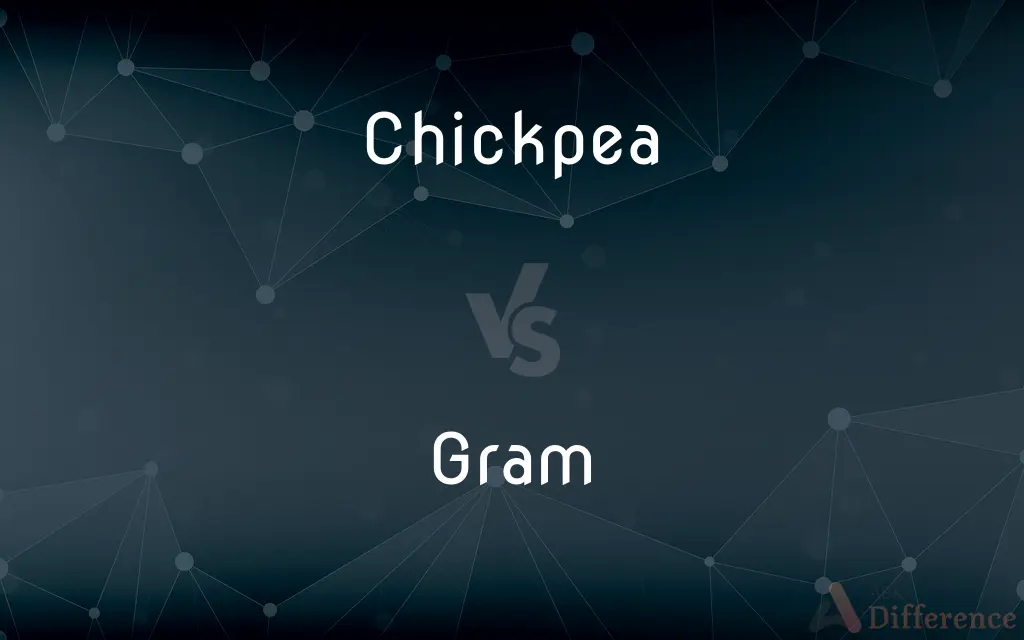Chickpea vs. Gram — What's the Difference?
By Maham Liaqat & Urooj Arif — Updated on May 2, 2024
Chickpea refers to the round, beige seeds used in many cuisines, particularly in Mediterranean and South Asian dishes, while gram is a common term in Indian English for chickpeas, especially used when referring to various forms like flour.

Difference Between Chickpea and Gram
Table of Contents
ADVERTISEMENT
Key Differences
Chickpeas are legumes known for their round shape and nutty flavor, commonly used in Mediterranean dishes like hummus and falafel. Whereas, gram, often referred to in the context of Indian cuisine, includes the same chickpeas but is also used to make besan or gram flour, which is a staple in Indian cooking for dishes like pakoras.
Chickpeas are cultivated primarily in the Mediterranean, Middle Eastern, and South Asian regions, highlighting their adaptability to different climates and soils. On the other hand, the term "gram" is specifically prevalent in South Asia, emphasizing its cultural and culinary significance in this region.
In nutritional content, chickpeas are a rich source of protein, dietary fiber, and complex carbohydrates. On the other hand, gram, when milled into flour, is particularly valued for its versatility in gluten-free recipes and its ability to provide a protein-rich base for vegetarian dishes.
Chickpeas in their whole form are often used in salads, soups, and stews, maintaining their form and adding texture to dishes. Conversely, gram flour is a fine powder used as a binding agent in batters, a thickener for sauces, and a base for flatbreads.
While chickpeas are commonly available in canned and dried forms in supermarkets around the world, gram flour might be found in specialized ethnic stores or sections, reflecting its specific use in certain culinary traditions.
ADVERTISEMENT
Comparison Chart
Primary Usage
Whole in dishes like salads and soups
Milled into flour for batters and breads
Cultural Significance
Prominent in Mediterranean cuisine
Integral to South Asian (especially Indian) cuisine
Form Availability
Available in dried and canned forms
Typically available as flour or whole dried legumes
Culinary Applications
Used whole in various dishes
Ground into flour for diverse culinary uses
Nutritional Highlight
High in protein and fiber
Flour is high in protein, used in gluten-free recipes
Compare with Definitions
Chickpea
A plant from the family Fabaceae, producing edible seeds.
The chickpea plant grows to about 20–50 cm in height.
Gram
Another term for chickpeas in Indian English, used especially when referring to flour.
Gram flour is made from ground chickpeas.
Chickpea
Commonly found in canned or dried forms in grocery stores.
I bought a can of chickpeas to add to my salad.
Gram
A staple ingredient in Indian cooking.
Gram flour is used to make rotis in many Indian homes.
Chickpea
Integral to Mediterranean and Middle Eastern cuisine.
Chickpeas are used extensively in dishes like falafel.
Gram
Used in various forms for snacks, batters, and sweets in India.
Gram flour sweets are popular during festivals.
Chickpea
A small, round, beige legume used in various dishes.
Chickpeas are essential for making traditional hummus.
Gram
Available primarily in dried or flour form.
I need to pick up some gram for tonight's recipe.
Chickpea
An ingredient rich in protein and dietary fibers.
Chickpeas can be a meat substitute in vegetarian diets.
Gram
Often used to make besan, a flour used in many Indian recipes.
Gram is the base for making delicious pakoras.
Chickpea
The chickpea or chick pea (Cicer arietinum) is an annual legume of the family Fabaceae, subfamily Faboideae. Its different types are variously known as gram or Bengal gram, garbanzo or garbanzo bean, or Egyptian pea.
Gram
The gram (alternative spelling: gramme; SI unit symbol: g) is a metric system unit of mass. Originally defined as "the absolute weight of a volume of pure water equal to the cube of the hundredth part of a metre [1 cm3], and at the temperature of melting ice" (later at 4 °C, the temperature of maximum density of water).
Chickpea
An annual Asian plant (Cicer arietinum) in the pea family, widely cultivated for the edible seeds in its short inflated pods.
Gram
A metric unit of mass equal to one thousandth (10-3) of a kilogram. See Table at measurement.
Chickpea
A seed of this plant. In both senses also called garbanzo.
Gram
Any of several legumes, such as the chickpea, bearing seeds used as food.
Chickpea
An annual Asian plant (Cicer arietinum) in the pea family, widely cultivated for the edible seeds in its short inflated pods.
Gram
The seeds of such a plant.
Chickpea
A seed of this plant, often used as a food.
Chickpea is valued for its nutritive seeds with high protein content.
Gram
A grandmother.
Chickpea
The seed of the chickpea plant
Gram
A unit of mass equal to one-thousandth of a kilogram. Symbol: g.
Chickpea
Asiatic herb cultivated for its short pods with one or two edible seeds
Gram
A leguminous plant grown for its seeds, especially the chickpea.
Chickpea
Large white roundish Asiatic legume; usually dried
Gram
(uncountable) The seeds of these plants.
Gram
Grandmother.
Gram
(US) graham
Gram
(colloquial) 'gram
Gram
Angry.
Gram
The East Indian name of the chick-pea (Cicer arietinum) and its seeds; also, other similar seeds there used for food.
Gram
A metric unit of weight equal to one thousandth of a kilogram
Gram
Danish physician and bacteriologist who developed a method of staining bacteria to distinguish among them (1853-1938)
Common Curiosities
What is gram?
Gram is a term used in Indian English for chickpeas, particularly when referring to them in the form of flour or whole dried legumes.
What are chickpeas?
Chickpeas are a type of legume, known for their nutty flavor and high nutritional value.
What are the main uses of gram in cooking?
Gram is primarily used to make flour known as besan, which is utilized in batters, breads, and snacks.
How are chickpeas used in cooking?
Chickpeas are used whole in salads, soups, stews, and as a primary ingredient in dishes like hummus.
What is a common dish made with gram flour?
Pakoras are a popular snack made using gram flour as a batter to fry vegetables.
Can I substitute gram flour for regular flour?
Gram flour can substitute regular flour in many recipes, especially for gluten-free and protein-rich preparations.
Are chickpeas and gram the same thing?
Yes, gram is just another name for chickpeas, particularly in the context of Indian cuisine.
Can chickpeas be eaten raw?
No, chickpeas should be cooked before eating as raw chickpeas can be difficult to digest.
What is a popular dish made with chickpeas?
Hummus is a popular dish made from mashed chickpeas, typically seasoned with tahini, lemon juice, and garlic.
Is gram flour gluten-free?
Yes, gram flour, which is made from chickpeas, is naturally gluten-free.
How do you store gram flour?
Gram flour should be kept in an airtight container in a cool, dry place to prevent it from absorbing moisture.
What is the difference in nutritional content between chickpeas and gram flour?
While both are high in protein and fiber, gram flour is denser in calories and nutrients due to its concentrated form.
How do you store chickpeas?
Dried chickpeas should be stored in an airtight container in a cool, dry place, whereas canned chickpeas need to be refrigerated after opening.
Are chickpeas good for health?
Yes, chickpeas are high in protein, fiber, and essential nutrients, making them a healthy dietary choice.
Why might someone prefer chickpeas over gram flour?
Some might prefer whole chickpeas for their texture and flavor in dishes, whereas others might opt for gram flour for its versatility in cooking.
Share Your Discovery

Previous Comparison
Haddock vs. Whitefish
Next Comparison
Interkinesis vs. InterphaseAuthor Spotlight
Written by
Maham LiaqatCo-written by
Urooj ArifUrooj is a skilled content writer at Ask Difference, known for her exceptional ability to simplify complex topics into engaging and informative content. With a passion for research and a flair for clear, concise writing, she consistently delivers articles that resonate with our diverse audience.
















































